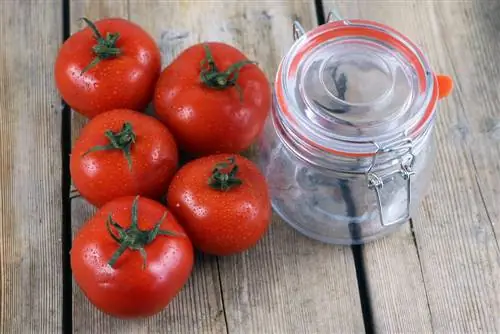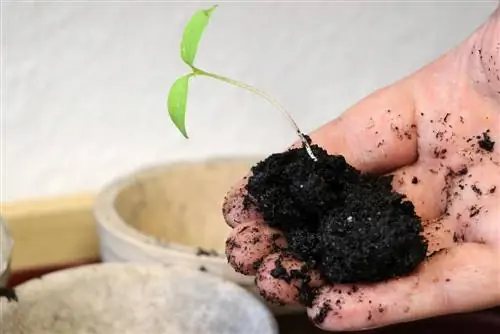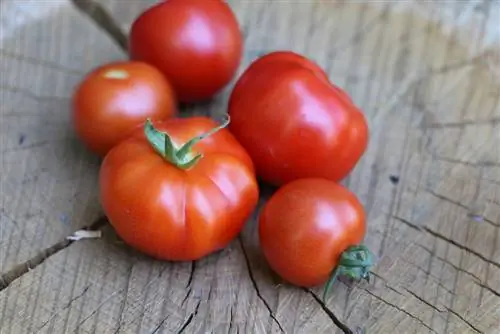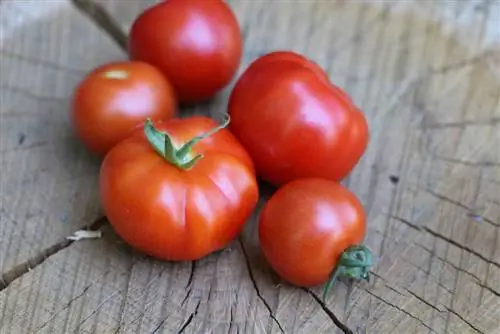- Author admin [email protected].
- Public 2023-12-17 03:39.
- Last modified 2025-01-24 12:45.
Tomato plants are particularly susceptible to fungal diseases. As a result, the plants can die within a few weeks after one harvest cycle. With the right plants as neighbors, you can promote perennial he alth and a bountiful harvest.
Advantages of mixed culture
Mixed culture is a concept that has developed over generations. It was observed which types of vegetables have a positive or negative effect on the vegetables in the immediate area. Especially with sensitive plants such as tomatoes, it is important to pay attention to the right plant neighbors and not to plant unsuitable vegetables or herbs in the immediate vicinity.
Positive effects of mixed cultures:
- mutual pest defense
- Prevention of illnesses
- optimal use of available space
- optimal use of available nutrients
Another advantage of mixed crops is that the plants can protect themselves even in extreme weather. For example, tomato plants appreciate consistently moist soil, which can be achieved by plants that cover the ground well. But the tomato is also a sun worshiper and plants that can't tolerate too much sun thrive in its shade.
Note:
In addition to good and bad partners, there are also so-called neutral neighboring plants. They hardly support each other, but there are no negative effects if they are planted right next to each other.
Good planting neighbors
The classic combination with tomato plants is basil. Not only because it is convenient when harvesting, as both are often eaten together, butBasilkeeps whiteflies away and prevents mildew. ChamomileandGarlic,, which are suitable as good partners in the tomato bed, also have fungicidal properties.

More good combinations:
- Salads
- Nasturtium
- Bush beans
- Carrots
- Mint
- Spinach
- Marigolds
When choosing suitable partners, if you plant other vegetables in the bed, you should make sure that the good neighbors of the tomato also get along with other vegetables.
Note:
Tomato plants are susceptible to late blight, so combinations with crops that have fungicidal effects should be preferred. This includes mixed cultures with vegetables from the allium family.
Tomatoes as supporters
Not only are tomato plants protected by good partners, the tomatoes themselves are good partners for other crops. In the case of nasturtiums or beans, their intense smell acts as a defense against aphids. Pests on beans are also repelled by the intense smell of the tomato plants.
Note:
Plant broths or manure can be made from removed shoots and leaves of tomato plants, which you can then use to ward off pests for other crops.
Heavy eater as a neighbor
Tomato plants are heavy feeders, which is why they are rarely planted next to other heavy feeders in mixed cultures. However, if there are more than enough nutrients in the soil, as long as the vegetables do not interfere with each other in any other way, there is nothing wrong with combining them with heavy feeders.
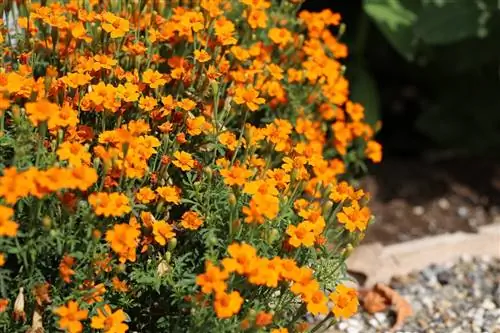
Therefore, the following plants are also suitable as neighbors for tomatoes:
- Maize (Zea mays)
- Root parsley (Petroselinum crispum subsp. tuberosum)
- Endives (Cichorium endivia)
- Spiced tagetes (Tagetes tenuifolia)
Difficult partnerships
In addition to completely unsuitable partnerships, there are also neighbors with whom the tomatoes tend to have a difficult relationship. They don't fit into any category because the impact on each other is not desired or desired by every hobby gardener.
Celery
Celery is often cited as a good partner for tomatoes. In principle, this partnership is not disadvantageous, but it can happen that the tomato fruits have a slight taste of celery. If this doesn't bother you or if the fruits are to be processed into soup anyway, then there is nothing wrong with this partnership.
cabbage
Cabbages and tomato plants also have a difficult relationship with each other. Towards autumn, dead plant parts of cabbage species promotelate blightin tomato plants. On the other hand, the intense smell of the tomato plants repelspests such as flea beetles or cabbage white butterflies on cabbage species. For this reason, only types of cabbage that grow quickly are suitable for mixed cultivation. These include, for example, kohlrabi or cabbage, which should be harvested early.
Cruciferous vegetables
In general, you should be careful with plants from the cruciferous family, as they are also susceptible tolate blight. Limited neighbors are therefore only suitable for tomato plants: cruciferous vegetables that also grow quickly, such as:
- Radish
- Garden cress
- Arugula
- Mustard
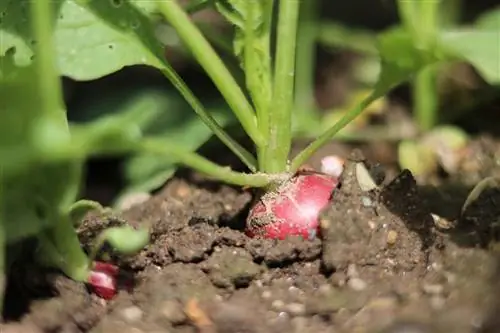
Bad Neighbors
There are some combinations that are neither good nor neutral, but on the contrary are actually harmful.
Solanaceae
These primarily include plants that, like the tomato plant, also belong to the nightshade family. Nightshade plants are susceptible to the same diseases and pests:
- Potatoes
- Peppers
- Aubergines
in the combination, for example, there is a great source of food for Colorado beetles.
Pumpkin
Tomato plants and cucurbits are also a bad combination. The main risk here is that mildew will spread quickly.
More Bad Neighbors
- Fennel
- Beetroot
- Chard
- Peas
- Red cabbage



